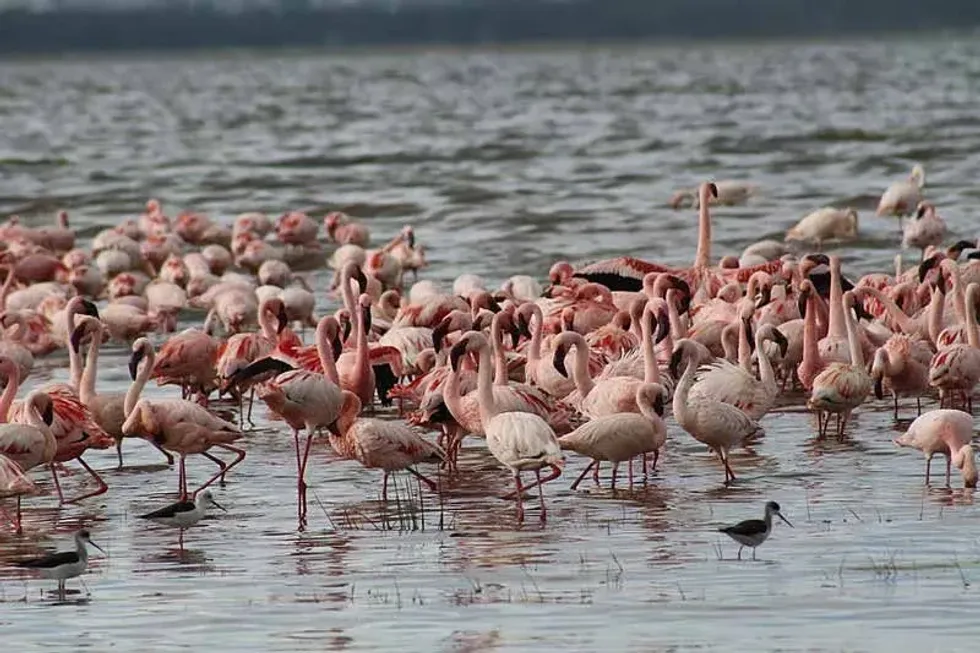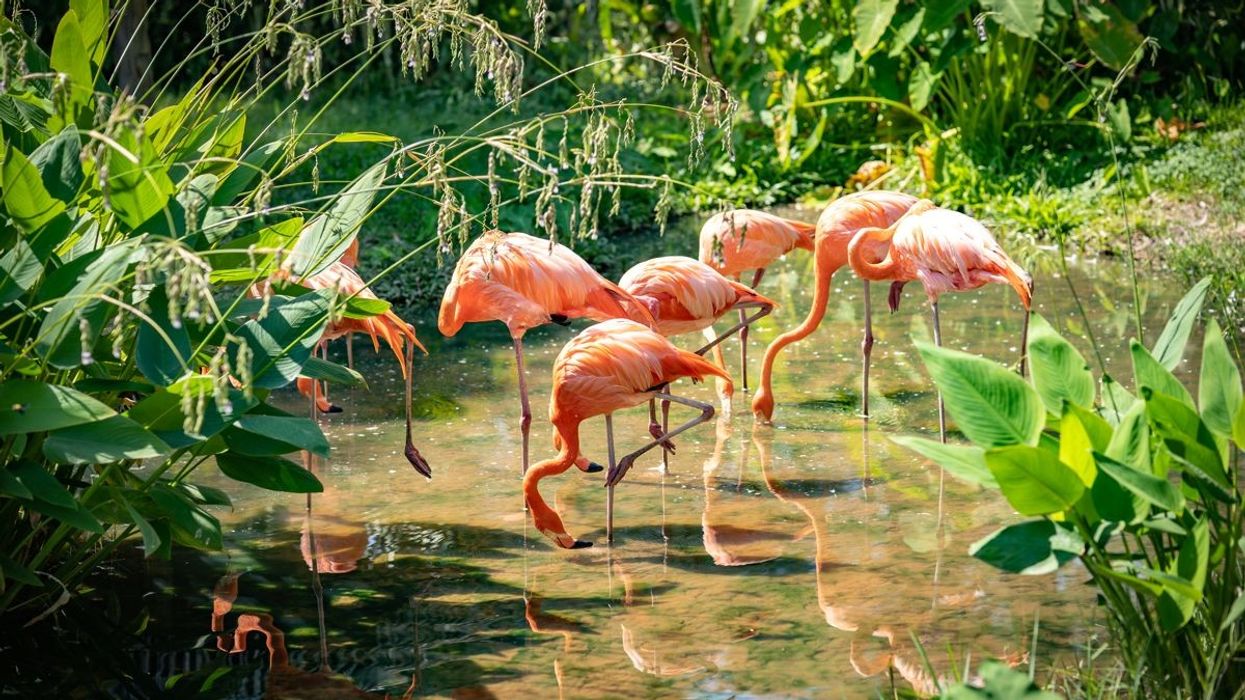The lesser flamingo, or Phoeniconaias minor according to its scientific name, is considered to be the smallest of the flamingo species. These lesser flamingos do not have a sense of taste or a sense of smell.
They are spotted feeding on small marine organisms in alkaline lakes. Their diet consists of different marine invertebrates like plankton, algae, and crustaceans. Their food consists of several other aquatic organisms that carry the cryptoxanthin chemical which leads to the bird's carotenoid pigmentation.
These birds are said to belong to a group of highly social birds that can live in large flocks, with a maximum of one million flamingos together. These birds have fossils dating back to 10,000,000 years ago. They are included in the list of some of the most ancient birds.
Read on for more interesting facts about these birds. To learn more about other species of this animal, check out our articles on greater flamingos and flamingos.
Lesser Flamingo Interesting Facts
What type of animal is a lesser flamingo?
Lesser flamingos are birds that belong to the Phoenicopteridae family of animals.
What class of animal does a lesser flamingo belong to?
These flamingos like other similar species belong to the Aves class of animals.
How many lesser flamingos are there in the world?
These birds have a lower conservation rate. Their population range is 2,200,000-3,300,000 individuals across the world which is decreasing over time.
Where does a lesser flamingo live?
This bird population is wildly found in sub-Saharan Africa, South Africa, and Asia. Locations like India, East Africa, Botswana, Mauritania, Kenya, Namibia, Pakistan, Tanzania, Zambia, Senegal, and southern Africa are where most of the populations of these flamingos can be found.
What is a lesser flamingo's habitat?
These birds prefer alkaline and saline lakes, mudflats, coastal lagoons, locations with salt pans, and estuaries. Although these birds are not migratory, they travel to different locations that provide a suitable habitat. This happens if their current lake increases algae concentration or leads to a reduced supply of potassium, magnesium, and other chemicals preferred by them.
Who do lesser flamingos live with?
These birds are usually seen in flocks of hundreds and thousands of individuals living together. This is usually to keep predators away. These birds live in colonies and a flock is called a flamboyance.
How long does a lesser flamingo live?
These lesser flamingos have a good lifespan of up to 50 years of age.
How do they reproduce?
Not all lesser flamingos breed annually. Every bird breeds with a gap of five to seven years, which is also why its population is low.
Their breeding sites are located near muddy lakes or soda mudflats.
Their breeding season occurs between October and February. During the breeding season, males carry out a lengthy display in front of their huge flock to attract a female.
This display ritual consists of head and neck movements, like stiffening the neck and bringing it into a broken neck posture or doing wing salutes, giving red signals by flashing the red part of their tail, making different calls, and also by approaching their potential mate by walking ahead of them.
Once a female agrees to mate, the male climbs on top of the female and flaps its wings as a balancing act. Once the pair is done copulating, the male is seen moving around the female until she lays her egg.
These birds build mud nests that have three layers. These nests are built in colonies, where all the breeding pairs keep their single egg and protect it.
These eggs are then incubated by their parents for 28 days. The eggs usually hatch around the same time in the colonies and the parents feed the young ones with crop milk. After a period of two to three months, these young chicks can live on their own.
What is their conservation status?
Lesser flamingos are marked as Near Threatened species by the International Union for Control of Nature (IUCN) in their conservation list.
Lesser Flamingo Fun Facts
What do lesser flamingos look like?
Lesser flamingos are distinguished from other species by their pink plumage, big wings, slender pink legs, and dark red-colored bill, which might be mistaken for a black bill. This bill is big, angular in shape, and has thousands of palettes to help them filter blue-green algae and plankton which are a part of their diet.
They have a long neck which is usually seen in the typical S-shaped curve. Similarly, their feet are long, fully webbed, slender, and lean.
The primary and secondary feathers on their big wings are black. These flamingos also have golden-colored eyes with a purple-colored eye-ring, and males are usually bigger than females.
How cute are they?
This type of flamingo, Phoenicopterus minor, is considered to be cute because of its pink feathers and its unique ability to stand on one of its long pink legs in the water.
How do they communicate?
These birds usually communicate with different forms of displays, like moving their head from side to side, showing a broken neck posture, dancing with erect feathers, and goose-like calls. The intensity of these actions fluctuates based on whether they are communicating about food, predators, or attracting a mate. Chicks recognize their parents based on their sound variations.
How big is a lesser flamingo?
These birds are as big as 31-36 in (80-90 cm), with a height of up to 3 ft (91 cm). This is twice the size of a long-billed curlew, the largest shorebird.
How high can a lesser flamingo fly?
Although these birds can fly at higher altitudes with a speed of 37.2 mph (60 kph), the exact height of their flights is unknown.
How much does a lesser flamingo weigh?
This bird belonging to the land of Africa and Asia is known to have a weight range of 3-4.5 lb (1.5-2 kg).
What are the male and female names of the species?
No, they do not have different names.
What would you call a baby lesser flamingo?
A baby flamingo is called a chick.
What do they eat?
These birds do not have a sense of smell, nor do they have any sense of taste. Their flocks forage for their food together in large groups and their diet includes aquatic invertebrates, zooplankton, and crustaceans. Their key food supply is blue-green algae and micro-organisms.
Are they aggressive?
These birds from parts of Asia, as well as eastern and southern Africa, can get aggressive if other flamingos or predators come closer to their flock or their nests.
Would they make a good pet?
All flamingos are wild animals and they are not considered to be domesticated. Lesser flamingos are not said to make good pets and it is illegal to keep a flamingo as a pet.
Did you know...
Due to their fully webbed feet, these lesser flamingos are considered to be great swimmers. Additionally, these flocks of flamingos live in remote locations where they carry out their feeding to stay away from their predators.
How did the lesser flamingo get its name?
The lesser flamingo's name came from the Portuguese word 'phoeniconaias', meaning 'red' or 'blood feathered goose', which suits this species of flamingo perfectly because of its appearance and vocals.
Why are lesser flamingos pink?
These flamingos have a pink color because of the carotenoids found in the marine organisms that are included in their diet.
Here at Kidadl, we have carefully created lots of interesting family-friendly animal facts for everyone to discover! Learn more about some other birds including least tern, or red-crowned crane.
You can even occupy yourself at home by drawing one on our lesser flamingo coloring pages.










